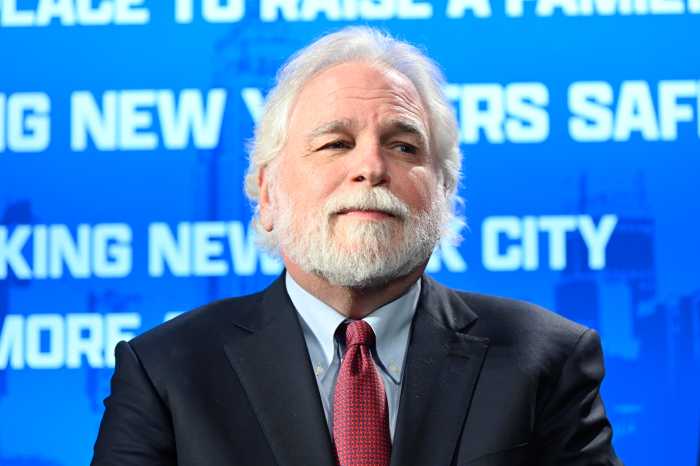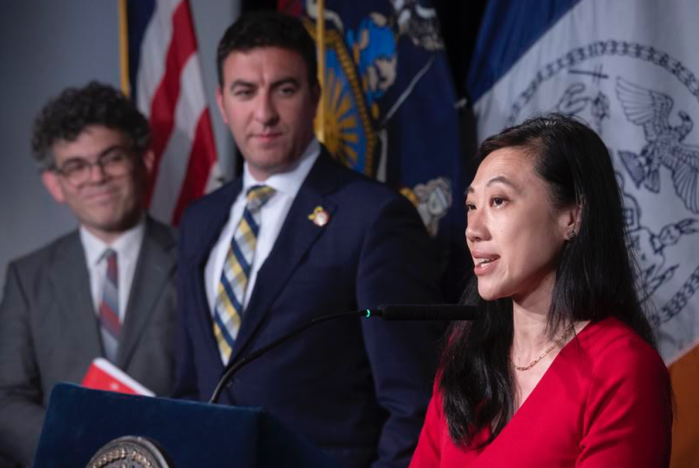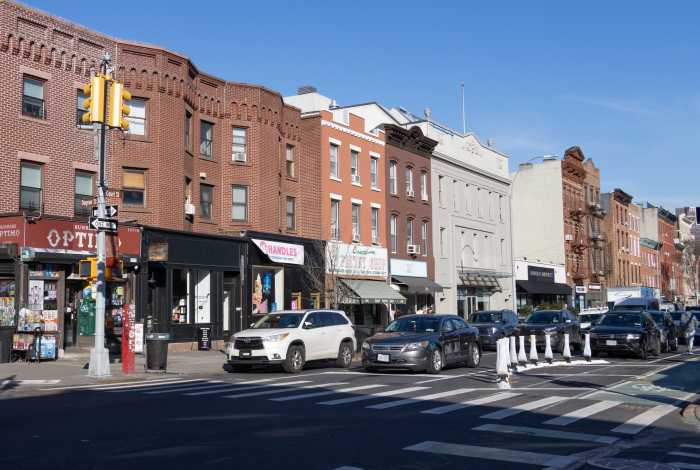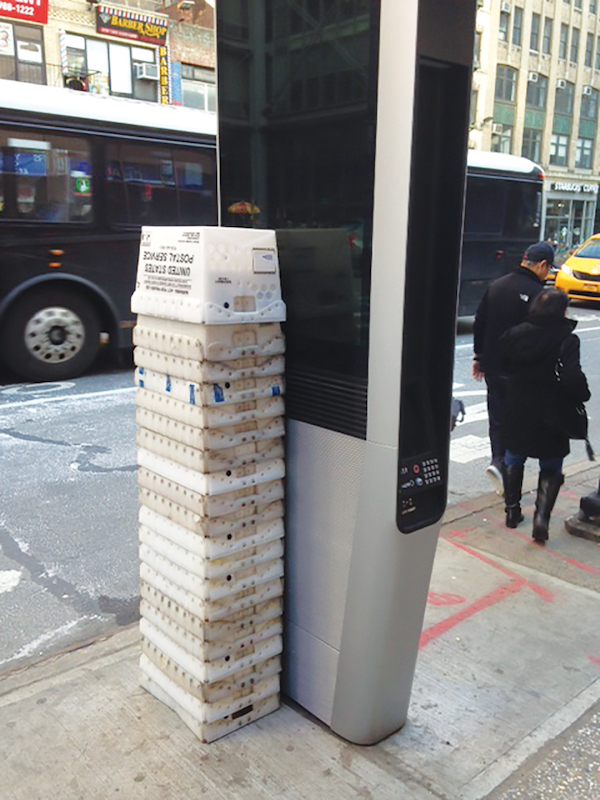
BY DUSICA SUE MALESEVIC | LinkNYC’s disabling of web browsing capabilities on its Wi-Fi kiosks this month points to an age-old tug of war in the city: balancing quality of life concerns with the implementing a new program.
In this case, what was touted as a plank to the building of a bridge over the city’s digital divide got marred by inappropriate use and the monopolization of kiosks. It is unclear whether the web browsing function will be reinstated. If not, a source of Internet accessibility for those of lower incomes and the homeless has been cut off.
Pamela Wolff, a longtime W. 21st St. resident, said she has seen several “performances” before the web browsing was disabled: a person dragging a newspaper distribution box from nearby, turning it sidewise, and setting up shop in front of a kiosk.
During the summer, one man did just — spending hours at a terminal on Eighth Ave. between. W. 21st & W. 22nd Sts.
“He’s just there in the middle of the sidewalk,” she said in a phone interview. “He had a nice long snooze [while wearing earphones that were hooked up to the kiosk]. He was there for the afternoon.”
Bill Borock, president of the Council of Chelsea Block Associations, said in a phone interview that people staying for a long time at the kiosks had been a problem and that “they blocked the sidewalk.”
Carol Ott, of the 300 W. 20th Street Block Association, said there was a tower between W. 20th and W. 21st Sts. on Eighth Ave. that people were gathering where there seemed to be drug use.
“It was making some people on the block uncomfortable who were walking by the kiosk,” Ott said in a phone interview.

Wolff, who has Internet access in her home, said she is of two minds when it comes to the kiosks.
“I can see it as a serious deterioration of the quality of life for people who live and work around them,” she noted, adding, “I like the idea that anyone can access information. I’m loathe to take away those capabilities.”
Wolff said she has sympathy for people who have never had their own entertainment center, and suddenly had access to one.
Richard Trifiro, social services manager at Holy Apostles Soup Kitchen (296 Ninth Ave., at 28th St.) said the kiosks have opened up a conversation about what people on the street need when it comes to Internet service and access to communication.
“There is some need that is not being met,” he said in a phone interview.
He called the kiosks a step up from the old phone booths; Wolff was also glad those were gone as well.
“I was happy to see them go up throughout the city,” Trifiro said. “I hope they don’t abandon it because of the kinks. It serves an important purpose.”
The Internet has become like a necessity, and there is some technology that is simply out of reach for people in a certain income bracket, Trifiro said.
“You almost need it to live,” he said. “Many of the things our people are looking to improve their lives [with], they need the Internet [for].”
For instance, any sort of employment search or applying for a job requires access to a computer and the Internet, Trifiro said.
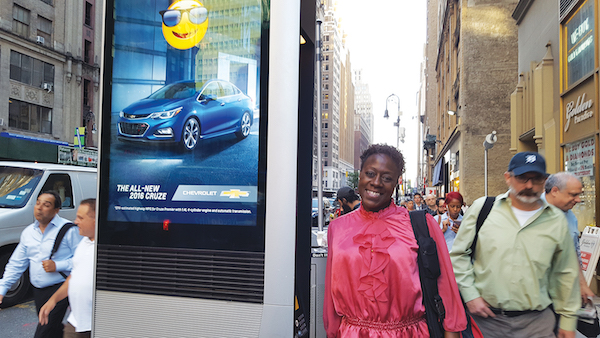
In New York City, 26% of households lack broadband Internet at home, and 16% do not have a computer at the home, according to “Internet Inequality: Broadband Access in NYC.” For the report, released in September 2015, Comptroller Scott Stringer’s office analyzed data from the Census Bureau’s American Community Survey.
According to the report, 40% of those with less than a high school education, lack broadband at home compared to 11% of those with a bachelors degree or more.
“Internet access has truly become the fourth utility, almost as critical to modern life as water, gas and electricity — but there is still unequal access across our city,” Stringer said in an email statement.
At Holy Apostles Soup Kitchen, Trifiro said they opened a computer lab about two and a half years ago. Initially, it had five computer stations — though over time, that amount doubled.
“It grew quite a bit,” Trifiro said. “We realized the need is great. The bulk of the people are using them for their own purposes — they need access.”
He said the reason the soup kitchen started the lab is because other places that offer Internet access, such as the library, sometimes turn away people who have the markers of being homeless or if they have poor hygiene.
Beyond the employment search, people who are homeless still need the Internet for connecting to people, mostly done now through social media, he explained.
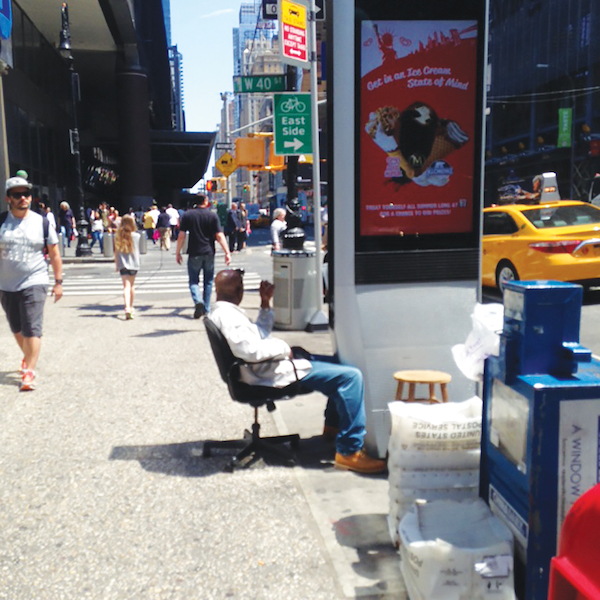
LinkNYC started rolling out earlier this year, and thus far 400 kiosks have been installed. The city awarded the bid to CityBridge — a consortium of companies that includes Intersection, Qualcomm, and CIVIQ Smartscapes — in November 2014, according to a Feb. 18 press release announcing the launch.
Natalie Grybauskas, a spokesperson for the Mayor’s Office, said in an email that LinkNYC’s purpose was always to bring free Wi-Fi to the city’s streets and sidewalks, and she pointed out that the tablets still provide access to city services through 311 online. She said there are other places in the city, such as libraries and New York City Housing Authority’s digital vans, where computers are available for public use.
“There were concerns about loitering and extended use of LinkNYC kiosks, so the mayor is addressing these quality-of-life complaints head on,” she said in an email. “Removing the Internet browser from LinkNYC tablets will not affect the other great services LinkNYC provides — superfast Wi-Fi, free phone calls, or access to key City services — but will address concerns we’ve heard from our fellow New Yorkers.”
BerlinRosen, the public relations firm representing LinkNYC, and the Department of Information Technology & Telecommunications (DoITT) declined to answer questions concerning a timeframe for bringing back web browsing or if it is permanently or temporarily disabled.
The New York Times reported on Sept. 14 — the day it was announced that the web browsing would be disabled — that “they would switch off the browsing functions on the computer tablets built into the kiosks as a temporary solution while they consider permanent changes.”
Chelsea Now spoke with block associations, community groups, and residents, and it seems that the problem kiosks were largely on Eighth Ave. However, the full scope of the issue is unclear, as both BerlinRosen and DoITT declined to answer questions concerning the number and nature of the complaints they received about the kiosks.
A BerlinRosen rep pointed to a Sept. 14 statement on LinkNYC’s website.
John A. Mudd, president of the Midtown South Community Council, said the problem “started blossoming in June.”
“They would play chess,” Mudd said in a phone interview. “They would watch porn. Music videos were big.”
Crowded around the kiosks, people would stay there all night and use overturned magazine/newspaper boxes and United States Postal Service crates as couches and chairs, he said. People were selling drugs at the kiosks, according to Mudd.
“The hottest spot was 40th and Eighth Ave. — it was a daily thing,” he said.
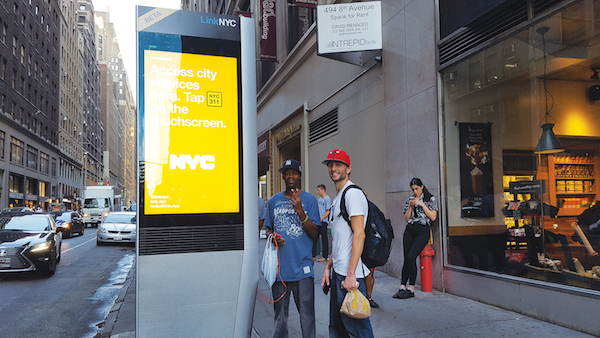
Business owners, hotel managers and residents came to Council meetings with complaints, he said.
Since the web browsing has been disabled, “it’s like night and day from what it was and now. It’s a tremendous change,” Mudd said.
President of the Garment District Alliance, Barbara Blair said, “The complaints started the minute the Links went into service.”
Blair said that was in April and that the Garment District Alliance, a business improvement district (BID) that spans 35th to 41st Sts. from Fifth to Ninth Aves., got complaints immediately and daily. The homeless gathered around the kiosks and would use thrown-out furniture to sit, she said.
“It can’t be used as an entertainment tool,” Blair said.
It exacerbated quality of life concerns in the area, which is unique due to its two transportation hubs, a parole board and social services located within it as well as a high number of pedestrians and panhandling, according to Blair.
Since the web browsing has been disconnected, Blair said they have received zero complaints.
“As soon as the thing was up and running … the homeless made it their encampment,” David Achelis, president of the West 50s Neighborhood Association, said in a phone interview. “Certain homeless take over certain towers and make them their own.”
Achelis, who is also a member of Community Board 5, said a kiosk in front of where he bartends (Matt’s Grill, 932 Eighth Ave. near W. 55th St.) has been a problem since around four months ago.
“No one knew what they would look like and how they would encroach on the neighborhood,” he said. “There are some places that the towers are so inappropriate; some they’re fine.”
He said the problem persists at the kiosk at 932 Eighth Ave. despite the web browsing being disabled, and he thinks that some of the towers need to be removed.
“These things are large,” Achelis said. “They are more useless advertising that communities don’t need.”
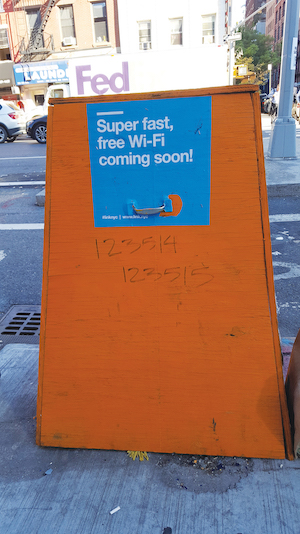
The Midtown South Community Council, the Garment District Alliance, the West 50s Neighborhood Association, the 300 W. 20th Street Block Association and others went to City Councilmember Corey Johnson’s office with complaints.
Johnson said in an email that his office got calls from constituents, and that he personally noticed some instances of abuse.
“It was clear from early on that this was a real problem for many constituents,” he wrote in an email to Chelsea Now. “When all of these various block associations and community councils and BIDs are reaching out at the same time about the same thing, you know that the issue is affecting a lot of people. It was really a resounding response.”
According to Johnson, constituents have been calling in and writing, expressing their appreciation since the web browsing has been disabled — but that his office is “not taking our eye off this yet.”
Currently, there is a moratorium on LinkNYC installing more kiosks on Eighth Ave. and Johnson said it will continue “until we’re confident that the big issues have been resolved. Things are looking better, but it’s too soon to install more kiosks. We’re in ‘wait and see’ mode right now.”
Along Eighth Ave., there are several orange boxes — that look like chopped off pyramids — announcing a LinkNYC is coming soon.
In response to questions concerning whether there is any NIMBY-ism involved with the complaints regarding the kiosks as the homeless had increased visibility, and what measures he supports to bring Internet access for those of lower income and the homeless, Johnson said the intention of LinkNYC was never to allow unlimited web browsing on the street.
“When it became clear that this was a side effect of this program, we had to address it and find a way to prevent people, regardless of housing status, from using these kiosks as personal computers,” he said. “Expanding access to technology among homeless New Yorkers is something we should absolutely pursue, but that’s a separate issue from resolving the problems that were at hand with LinkNYC.”
To connect to a kiosk’s Wi-Fi, a device is required (such as a smartphone). According to a Department of Consumer Affairs research brief titled “New York City Mobile Services Study from November 2015, 79% of those surveyed had a smartphone. In total, there were 935 respondents over a four-month data collection period, according to the study.
When Chelsea Now walked the stretch of Eighth Ave. from W. 14th St. to W. 40th St. during the late afternoon on Thurs., Sept. 22, no one was huddled around the kiosks — and no street furniture, such as newspaper boxes, had been pulled up to facilitate watching the monitor. Some kiosks were not in use, while others were being used to make calls or to charge phones.
Ian Defibaugh, 45, a Hell’s Kitchen resident was charging his phone at a kiosk at W. 26th St. and Eighth Ave.
“When they first put them up, I thought it was the dumbest idea,” he said.
Now, Defibaugh says he has been using them quite frequently.
“It’s been charging really, really fast,” Defibaugh said. “I’ve been very happy with it.”
James Gambardella, 24, agreed.
“It’s super convenient,” he said at a kiosk at W. 35th St. and Eighth Ave. “If you’re in a pinch, you can charge your phone.”
Gambardella, a Chelsea resident, was charging his phone while Damon Callaway, a Bronx resident, was also at the station.
Callaway, 52, said, “It’s a good thing for the public.” He said he uses the kiosk to charge his phone so he can listen to music on it. “I’ve got to put gas in the car,” he said with a smile, referring to charging his phone.
Three blocks up, on W. 39th St., Veronica Elliott, 50, was dismayed to learn that the web browsing had been disconnected. She had been using it look up information.
“Oh no, is it coming back?” she asked. “The Internet is very useful — especially if you don’t have a laptop.”
She added, “I think more people need the Internet than not. I don’t think they should discontinue the service.”




